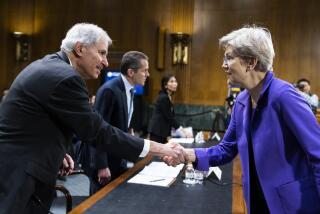Higher Capital Ratio Called Too Costly : Banks Object to Tightening Rules
- Share via
A proposal--tentatively endorsed Wednesday by Federal Reserve Chairman Paul A. Volcker--to raise banks’ minimum capital-to-asset ratio to 9% from 6% could weaken rather than strengthen the banking system and force consumers to pay higher fees for banking services, some industry officials said Thursday.
Other proposals cited by Volcker, including limiting dividends for troubled banks and charging insurance premiums on foreign deposits, also could be counterproductive or unnecessary, some bankers contended.
Alternative measures, such as basing capital requirements on the riskiness of a bank’s loan portfolio, might be more effective, they suggested.
“We believe there is no need for more capital,” said Fritz Elmendorf, a spokesman for the American Bankers Assn., the major industry lobbying arm. Elmendorf contended that there is “no demonstrated evidence that more capital is needed” to strengthen the banking system.
“The cost (of raising more capital) is going to be enormous, and that will negatively affect bank profits,” said Joseph J. Pinola, chairman and chief executive of Los Angeles-based First Interstate Bancorp. He added that a 9% capital ratio would not make any difference “if a bank has terrible management and is a failing bank.”
The industry reaction followed testimony by Volcker before the Senate Banking Committee that an increase to 9% in the minimum capital ratio is “attractive in concept and worthy of study.”
The powerful central banker said such a higher ratio would impose greater market discipline on banks and discourage highly risky lending policies.
Such concern about bank safety comes as bank failures this year have exceeded the 1984 total of 79, which was a post-Depression record. The failure of a bank in New Mexico brought the 1985 total to 80.
Bank capital, which includes shareholders’ equity, loan-loss reserves and certain kinds of debt, is viewed as a cushion against losses from bad loans. If the required ratio is higher, banks might be more careful when increasing assets such as loans, proponents contend.
The 9% requirement was suggested last year by Federal Deposit Insurance Corp. Chairman William Isaac as part of several ideas to strengthen the banking system.
His plan, which has been submitted to industry officials for comment but is not yet a formal proposal, would phase in the capital increase by half of a percentage point per year. It would also allow banks to fulfill the requirement of the three additional percentage points with subordinated debt.
Also under consideration at the FDIC is a proposal that would reduce the chances that deposits above $100,000 per customer per bank will be paid back in full in case of a bank failure. Such a scheme would ease the strain on the FDIC’s funds and encourage larger depositors to put their funds only in safer banks. A special committee of the American Bankers Assn. endorsed that proposal this week as preferable to a higher capital requirement.
Many bankers had dismissed the idea of a 9% capital rule, but some said Thursday that Volcker’s qualified endorsement gives it a great deal more credence. Stocks of major banking firms fell almost across the board in New York Stock Exchange trading Thursday, a development that bankers blamed largely on Volcker’s statements.
However, acceptance of the proposal by all regulators is not assured. The Office of the Comptroller of the Currency, which regulates all 4,500 of the nationally chartered banks out of a total of 14,800 banks, so far has opposed an across-the-board rise in minimum capital requirements, arguing instead that capital ratios should be based on risk, so that those banks with riskier loan portfolios should be required to have more capital.
Michael Patriarca, deputy comptroller for bank supervision, told the Senate Banking Committee on Wednesday that higher capital ratios enforced without regard to risk might force less scrupulous banks to engage in even riskier lending practices to boost their returns to investors, Patriarca said.
Or banks might change the terms of some of their loans and other assets so as to take them off their balance sheets, thus reducing the level of assets and raising the capital ratio without actually raising more capital, he said.
Comptroller spokeswoman Ellen Stockdale said it is unlikely that capital ratios would be raised unless such a rule were adopted by her office, as well as by the FDIC, which regulates about 9000 banks, and the Fed, which supervises about 1,000. (No congressional approval is required.)
However, she added, the position of Comptroller of the Currency, formerly held by C. Todd Conover, currently is vacant, and a new appointee may reverse the agency’s opposition to higher ratios.
The Independent Bankers Assn. of America, a lobbying group representing smaller banks, also opposes higher capital requirements even though most small banks already meet or exceed the 9% capital level. (The nation’s 12,000 banks with assets of $100 million or less have an average equity capital ratio of 9.1%, according to the FDIC.)
“The problem is not with the banks, it’s with the thrift industry,” said Kenneth Guenther, executive director of the independent bankers group, citing industry figures showing that capital levels for the nation’s savings and loan associations totaled only about 0.5% at the end of 1984.
Guenther said raising capital levels to 9% would force the industry to raise up to $60 billion in new capital, hurting profitability and forcing institutions to raise loan rates and fees charged to customers.
Not all bankers opposed higher capital requirements, however.
“We think it would be very constructive to raise capital requirements,” said Paul Hazen, president of San Francisco-based Wells Fargo Bank. He said regulators are quite capable of setting guidelines to guard against riskier lending practices or shifting of assets off balance sheets.
More to Read
Inside the business of entertainment
The Wide Shot brings you news, analysis and insights on everything from streaming wars to production — and what it all means for the future.
You may occasionally receive promotional content from the Los Angeles Times.









